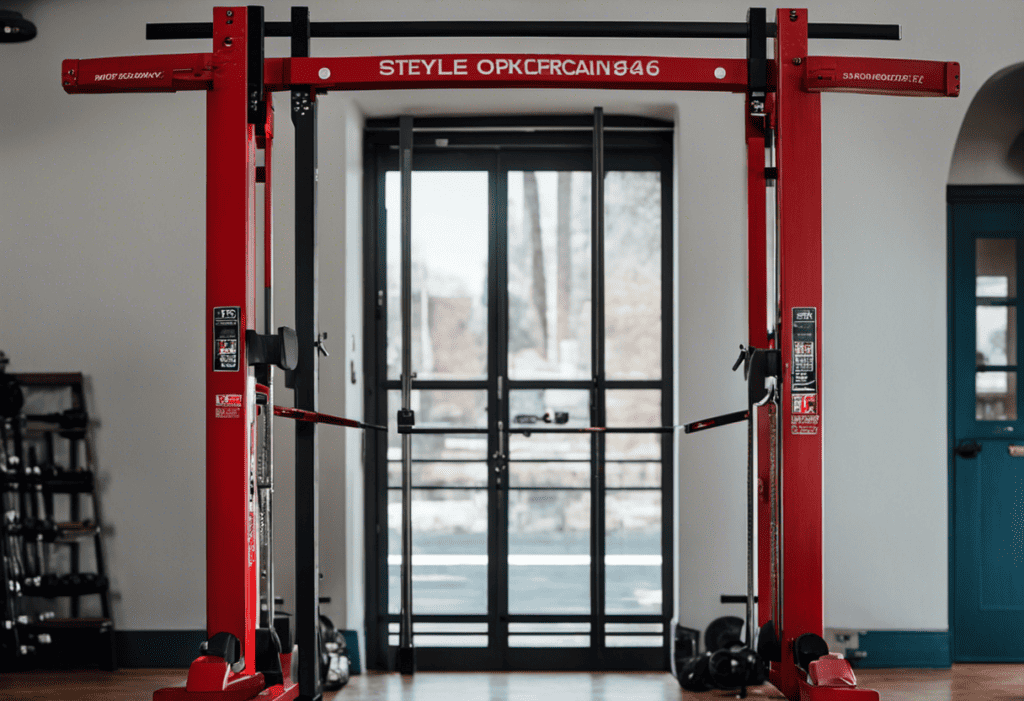
Image capturing the moment a sturdy door frame cracks under the weight of an overloaded pull-up bar, emphasizing the importance of weight capacity considerations
As an avid fitness enthusiast, I’ve always loved using pull-up bars to strengthen my upper body.
But recently, I discovered a shocking statistic: these bars can cause damage to door frames!
This revelation prompted me to investigate the topic and share my findings.
This article will explore the factors contributing to this hidden threat, weight capacity considerations, safer alternatives, and the importance of protective pads.
By the end, you’ll know to protect your door frames and stay fit.
Let’s dive in!
Key Takeaways
- Pull-up bars can cause dents and damage to the door frame.
- Choosing the right size, using padding, and ensuring door frame suitability can help prevent damage.
- Door frame pull-up bars are not recommended for people heavier than 220 lbs.
- Wall-mounted pull-up bars are a safer alternative to door-frame pull-up bars.
Factors Contributing to Door Frame Damage
One factor contributing to door frame damage is the improper installation of pull-up bars, which can lead to dents and other damage over time. Following the manufacturer’s instructions carefully during installation ensures proper support and stability.
Additionally, choosing the right size of pull-up bar for your door frame is essential to prevent any potential damage. It’s also important to regularly check for signs of wear and tear and address any issues promptly. You can minimise the risk of door frame damage by being proactive and taking preventive measures, such as using padding or protective mats.
However, door frame repair options are available to restore the frame’s integrity if damage occurs. It’s always advisable to consult a professional for the best repair options to ensure the longevity of your door frame.
Weight Capacity Considerations
I always make sure to take into account the weight capacity when choosing a pull-up bar for my door frame. It’s crucial to consider the weight capacity to ensure the safety and durability of both the pull-up bar and the door frame.
Door frame materials play a significant role in determining the weight capacity that the bar can support. Different materials have varying strengths and limitations, so it’s essential to assess the material of the door frame before selecting a pull-up bar.
Also, proper installation techniques are vital to prevent damage to the door frame. Ensuring that the pull-up bar is securely mounted and following the manufacturer’s guidelines for installation can help maintain the integrity of the door frame.
Safer Alternatives to Door Frame Pull-Up Bars
Wall-mounted pull-up bars offer a safer alternative to door-frame pull-up bars. When choosing a pull-up bar, it’s essential to prioritize safety and durability. Wall-mounted pull-up bars have several advantages over their door frame counterparts.
Here are three reasons why wall-mounted pull-up bars are a safer alternative:
- Stability: Wall-mounted pull-up bars are securely attached to the wall, providing a stable and sturdy platform for your workouts. This eliminates the risk of the bar slipping or falling during exercise.
- Weight Capacity: Wall-mounted pull-up bars typically have a higher weight capacity than door-frame ones. This means they can accommodate heavier individuals without compromising safety.
- Durability: Wall-mounted pull-up bars are built to withstand heavy use. They’re made from sturdy materials that can endure the strain of regular workouts, ensuring long-lasting performance.
Importance of Protective Pads
Protective pads are crucial for preventing damage to the door frame when using a pull-up bar. Choosing the suitable padding material and proper installation techniques are essential to ensure the safety and durability of both the pull-up bar and the door frame.
| Padding Material | Pros | Cons |
|---|---|---|
| Rubber | Sturdy and flexible | May leave marks on the door frame |
| Foam | Soft and cushioning | Poor quality and less durable |
| Neoprene | Durable and protective | Can be expensive |
When selecting padding material, it is important to consider its protection level and compatibility with the door frame material. Proper installation techniques, such as securely attaching the padding to the pull-up bar and ensuring a tight fit on the door frame, will further reduce the risk of damage. Taking these precautions will help maintain the integrity of the door frame and prevent costly repairs or accidents.
Long-Term Impact on Door Frame Durability
Over time, pull-up bars can gradually weaken and damage the door frame, potentially leading to costly repairs or even accidents. To prevent such damage, here are some maintenance tips and repair options to consider:
Maintenance Tips:
- Regularly inspect the door frame for signs of wear and tear caused by the pull-up bar.
- Ensure proper mounting and installation of the pull-up bar to minimize stress on the door frame.
- Use protective padding or rubber grips to prevent direct contact between the pull-up bar and the door frame.
Repair Options:
- If you notice any dents or damage to the door frame, consider repairing it as soon as possible to prevent further deterioration.
- Seek professional help for repairing extensive damage or structural issues.
- In some cases, it may be necessary to replace the door frame entirely if severe damage occurs.
Frequently Asked Questions
How Can I Determine if My Door Frame Is Suitable for a Pull-up Bar Installation?
I must consider the dimensions, material, and weight capacity to determine if my door frame suits a pull-up bar installation. Proper installation and choosing the right pull-up bar are crucial for safety and avoiding damage.
Are There Any Weight Capacity Recommendations for Wall-Mounted Pull-up Bars?
Weight capacity recommendations for wall-mounted pull-up bars vary depending on the design and material quality. It is important to consider your weight before installation to ensure suitability and minimize the risk of damage.
What Are Some Signs of Wear and Tear to Look Out for on a Pull-up Bar?
Some signs of wear on a pull-up bar include rust, loose screws, and worn-out grips. Suitable installation is crucial to prevent damage. Regular inspection and maintenance can help identify signs of wear and tear.
Can I Use Foam Padding Instead of Rubber Padding for Protection?
No, foam padding is not recommended as an alternative to rubber padding for protection. Foam padding is of poor quality and may not effectively prevent damage. It is important to choose a pull-up bar with proper padding to minimize impact on door frame durability.
How Can I Minimize the Long-Term Damage to My Door Frame Caused by a Pull up Bar?
To minimize long-term damage to my door frame caused by a pull-up bar, I can reinforce it with steel brackets or doorway gym bars. Additionally, I can explore alternatives like wall-mounted pull-up bars for a safer workout experience.
Are Pull Up Bars Safe to Use on Load-bearing Door Frames?
Yes, the surprising truth about door frames is that pull up bars can be safe to use on load-bearing door frames if installed properly. However, it’s essential to follow the manufacturer’s instructions and ensure the door frame can support the weight before using a pull-up bar.
Door Fitness
Fitness enthusiasts must know the potential risks of using pull-up bars on door frames. Improper installation, wrong product choice, and mismatched dimensions can all contribute to damage.
By considering weight capacity, exploring safer alternatives, and using protective pads, individuals can mitigate these risks and protect the durability of their door frames.
Let’s not underestimate the hidden threat behind our fitness routines and take the necessary precautions for a safer and more sustainable workout experience.







